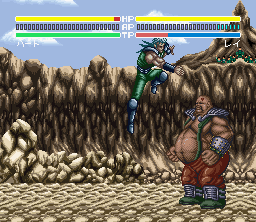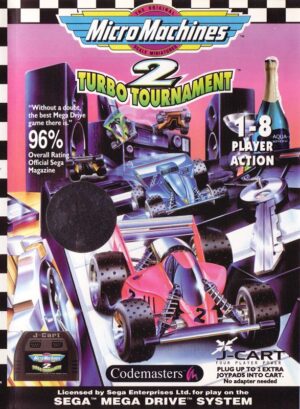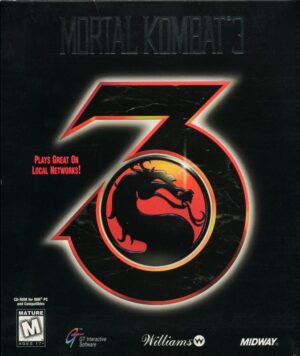Retro Replay Review
Gameplay
Hokuto no Ken 6: Gekitō Denshōken Haō e no Michi marks a bold departure from the RPG mechanics of installments 3–5 and the platforming roots of the original two titles, delivering a classic one-on-one fighting experience in the vein of Street Fighter II and Mortal Kombat. The core loop revolves around selecting a legendary martial artist—Kenshiro, his brother Raoh, Nanto Seiken masters Rei and Souther, the assassin Heart, and more—and duking it out in high-stakes duels. Each character boasts a unique move set that blends iconic manga attacks with standard fighting‐game fundamentals like special moves, throws, and aerial combos.
Controls are intuitive yet deep: basic punches and kicks map to simple button presses, while quarter-circle and charge motions unleash trademark Hokuto and Nanto techniques. Filling your energy bar is critical; once charged, you can execute devastating “Hokuto Hyakuretsu” onslaughts or Nanto strikes that are as visually satisfying as they are damaging. The pacing strikes a solid middle ground—matchups feel brisk, but there’s enough weight behind each hit to reward precise timing and strategic meter management.
The game offers two main modes: a Free Fight mode, where you can cycle through the entire roster at your leisure, and a two-player versus mode that unleashes the full competitive potential when a friend picks up the second controller. AI opponents scale in difficulty reasonably, ensuring that newcomers can learn the ropes without being overwhelmed, while veterans can challenge themselves with tougher CPU patterns. Add in the occasional environmental hazard or stage gimmick, and you have a well-rounded package that keeps encounters fresh.
Graphics
Visually, Gekitō Denshōken Haō e no Michi stays faithful to Tetsuo Hara’s gritty art style, translating the post-apocalyptic landscapes and muscular character designs of the manga into vibrant 16-bit sprites. Each fighter is meticulously animated, with smooth transitions between standing, jumping, and combo sequences. Signature moves like Kenshiro’s Hundred Crack Fist crackle with energy, accompanied by bold flashes and dramatic slow-mo effects that evoke the series’ violent flair.
Stage backgrounds capture the world of 199X in all its ruinous glory—from dilapidated cities littered with debris to barren wastelands where rival warriors clash under a blood-red sky. Parallax scrolling layers and subtle weather effects, such as drifting sandstorms or flickering flames, give environments a surprising level of depth and atmosphere. Even on the hardware of its era, the game pushes the limits of color palettes to ensure each locale feels distinct and immersive.
User interface elements—life bars, timer, and energy meters—are bold and clear, following the established fighting-game conventions without cluttering the action. Character portraits that flank the health bars light up dynamically during super moves, adding a layer of visual feedback that heightens the drama. In two-player matches, split-screen fades are handled cleanly, maintaining readability at all times. Overall, the graphics strike a perfect balance between faithful adaptation and functional design.
Story
While the narrative in a one-on-one fighting game is necessarily streamlined, Hokuto no Ken 6 roots every bout in the lore of the post-apocalyptic saga. The year is 199X, civilization has crumbled, and the land is dominated by ruthless martial artists seeking supremacy. Each character’s profile page recounts their personal vendetta—whether Kenshiro’s quest to rescue innocents, Raoh’s iron-fisted conquest, or Rei’s quest for vengeance against those who wronged his comrades.
Between fights, short dialogue boxes and splash art hint at shifting alliances and the characters’ inner conflicts, bridging the gap between manga chapters. Though there’s no full-blown story mode with branching paths, the order of opponents in Free Fight reflects a loose campaign structure: start with lower-tier challengers, work your way up to the Four Celestial Kings, and ultimately face the mighty Raoh. This progression injects a sense of narrative momentum into the otherwise straightforward arcade experience.
For fans of the anime and manga, cameo appearances by supporting characters and brief cutscenes of devastated settlements bolster the emotional weight of each confrontation. While newcomers may miss some contextual nuance, the game’s vivid character art and biting one-liners ensure that motivations remain clear. In short, the story serves its purpose: fueling epic showdowns and reminding players why each punch lands with such mythic significance.
Overall Experience
Hokuto no Ken 6: Gekitō Denshōken Haō e no Michi succeeds in reinventing its own franchise with a satisfying fighting-game formula. It strikes a harmonious balance between pick-up-and-play accessibility and the depth hardcore fans crave, thanks to varied move sets, meter management, and strategic options in both single-player and two-player formats. Whether you’re a series aficionado or simply in search of a competent Street Fighter–style brawler with a dark, gritty aesthetic, this entry has plenty to offer.
Replayability is high: mastering each character’s secret combos, discovering stage hazards, and challenging friends in local versus matches can easily extend playtime well beyond the initial campaign. The modest AI scaling keeps solo runs engaging without feeling punishing, while two-player bouts often lead to heated rivalries as you unlock every devastating technique. There’s also a hidden satisfaction in watching a perfectly timed Nanto execution or Hokuto finish, which never loses its cathartic punch.
Ultimately, Gekitō Denshōken Haō e no Michi stands out as a faithful yet fresh take on both the Hokuto no Ken universe and the 16-bit fighting-game scene. It may lack an elaborate story mode, but its core gameplay loop is rock-solid, its presentation is stylishly brutal, and its roster is brimming with fan-favorite warriors. If you appreciate classic arcade fighters and long for the raw intensity of post-apocalyptic martial arts, this title is a must-have addition to your collection.
 Retro Replay Retro Replay gaming reviews, news, emulation, geek stuff and more!
Retro Replay Retro Replay gaming reviews, news, emulation, geek stuff and more!









Reviews
There are no reviews yet.